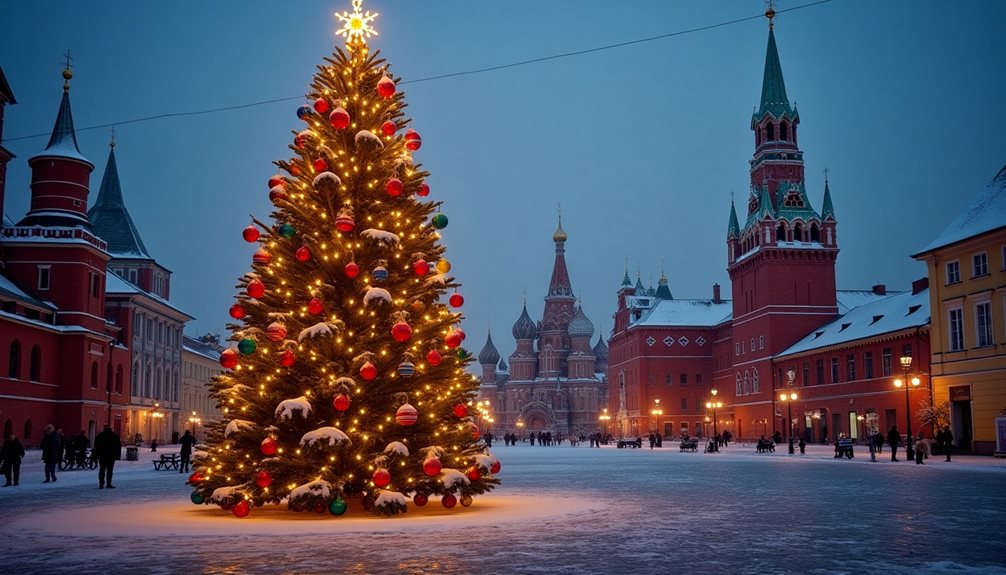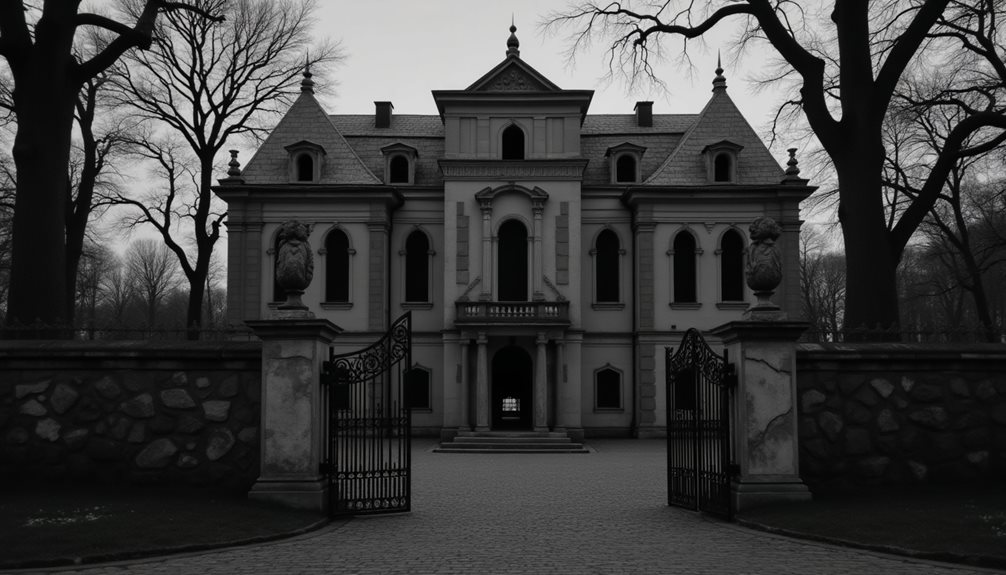When you explore the life of Vladimir Komarov, you uncover a story marked by bravery and tragic sacrifice. Born in Moscow, Komarov’s journey from the Soviet Air Force to becoming a pioneering cosmonaut showcases remarkable achievements and profound challenges. His role in the Voskhod 1 mission as part of a multi-crewed spaceflight was groundbreaking, yet it’s his ill-fated Soyuz 1 mission that continues to provoke deep reflection. What went wrong during that critical mission, and how did it transform the future of space exploration? The answers reveal a legacy that intertwines heroism with cautionary lessons.
Early Life and Education
You’re about to learn about Vladimir Komarov’s roots and formative years.
Born in Moscow, he developed an early passion for aviation, which led him to join the military.
His education at the First Moscow Special Air Force School and the Zhukovsky Air Force Engineering Academy set the stage for his future as a cosmonaut.
Birth and family background in Moscow
Vladimir Komarov was born on March 16, 1927, in Moscow, the vibrant capital of the Soviet Union. Growing up in this bustling metropolis, you’ve got to imagine the kind of formative experience he had.
His Moscow upbringing was steeped in the rich cultural heritage of the city, where every street corner seemed to pulsate with history and revolution. Family influence played a pivotal role in Komarov’s early years. His parents were hardworking individuals who instilled in him a sense of duty and ambition.
They nurtured his early aspirations, encouraging him to dream big and reach for the stars—quite literally, as it would turn out. The childhood environment he was immersed in was one of resilience and determination, crucial traits that would later define his career.
Living in Moscow, Komarov was surrounded by a city that was constantly evolving, a place where the old world met the new. This dynamic setting provided a fertile ground for his burgeoning interests.
From an early age, he was captivated by the possibilities that lay beyond the Earth’s atmosphere, a fascination that would drive him to become one of Russia’s most celebrated cosmonauts.
Early interest in aviation and military service
Komarov’s fascination with aviation took hold early in his life, fueled by the rapid advancements in aerospace technology and the soaring achievements of Soviet pilots.
Growing up in Moscow, you would’ve seen a young Vladimir captivated by tales of pioneering aviators and their daring exploits. The skies weren’t just the limit; they were an invitation.
Aviation influences surrounded Komarov, igniting his passion for flight. He found early inspirations in the stories of heroic Soviet pilots who pushed the boundaries of what was possible.
These role models weren’t just names in history books; they were living proof that the sky could be conquered by those daring enough to dream.
Eager to follow in their footsteps, Komarov didn’t waste any time. He enlisted for military training, which offered a direct path to the cockpit.
In the military, you learn discipline, resilience, and the importance of precision—all qualities Komarov embodied.
This rigorous training didn’t just prepare him for a career; it solidified his commitment to aviation.
Komarov’s early interest in aviation and military service set the stage for a life dedicated to flight.
His passion for flight wasn’t just a childhood dream; it was a calling that guided his every step.
Komarov’s Education
Immersed in the world of aviation, Komarov’s next logical step was formal education to hone his skills. You can imagine the thrill he felt walking into the First Moscow Special Air Force School, where he delved deep into aviation technology. This wasn’t just about flying planes; it was an all-encompassing experience that included rigorous military training and exposure to cutting-edge aerospace advancements.
At the school, Komarov didn’t just learn to fly; he mastered the intricate engineering principles that keep an aircraft soaring. You’d be amazed at how comprehensive his education was. He participated in flight simulations that tested his skills under various conditions, preparing him for real-world challenges. This hands-on training was crucial for someone destined for the cosmos.
Afterward, Komarov took his education a step further by enrolling in the prestigious Zhukovsky Air Force Engineering Academy. Here, he immersed himself even more deeply in the complexities of aerospace advancements and engineering principles.
The Academy’s demanding curriculum ensured he was well-versed in both theoretical knowledge and practical application, making him a formidable force in the air and, eventually, in space. This rigorous education laid the foundation for Komarov’s future achievements as a cosmonaut, embodying the freedom and exploration he so cherished.
Career in the Soviet Air Force
As you explore Komarov’s career in the Soviet Air Force, you’ll find he started as a skilled fighter pilot before becoming a renowned test pilot.
His impressive achievements and steady promotions showcased his exceptional talents.
Eventually, these accomplishments led him to transition into the Soviet space program, marking a new chapter in his distinguished career.
Initial roles as a fighter pilot and test pilot
Vladimir Komarov’s journey in the Soviet Air Force began with his roles as a fighter pilot and test pilot, where he honed his skills and demonstrated exceptional aeronautical prowess. You can imagine the intense fighter pilot training Komarov underwent, pushing him to master aviation techniques essential for success in military aviation. Each flight tested his limits, but also revealed his natural talent and dedication to the skies.
Transitioning to the role of a test pilot, Komarov didn’t just fly aircraft; he became instrumental in advancing aerospace engineering. He rigorously tested new planes, ensuring they met the highest standards of performance and safety. His test pilot skills were unparalleled, allowing him to identify potential flaws and suggest critical improvements. In this role, he wasn’t just a pilot but an innovator, contributing to the evolution of aviation technology.
In the high-stakes world of military aviation, Komarov’s expertise stood out. He approached every mission with a fearless spirit, embodying the freedom and precision that only the best aviators possess. His early experiences laid a solid foundation for his future endeavors, setting the stage for a remarkable career in the cosmos.
Achievements within the Soviet Air Force
Komarov’s remarkable skills didn’t go unnoticed within the Soviet Air Force, leading to a series of significant achievements and rapid promotions. Through rigorous military training, he honed his abilities and quickly distinguished himself as a top-tier pilot. His remarkable Air Force achievements included mastering various aircraft and excelling in high-stakes missions that required unparalleled precision and bravery.
Your journey through his career would reveal a man driven by excellence and recognized for his contributions. Komarov’s pilot recognition came not just from his flying prowess but also from his keen leadership abilities. He was trusted with critical leadership roles, guiding teams through complex operations and ensuring mission success.
The Soviet promotions he received were a testament to his unwavering dedication and exceptional performance. Rising through the ranks, Komarov transitioned from a promising pilot to a key figure within the Air Force, each step marking a new chapter of accomplishment.
His story serves as a powerful reminder that with skill and determination, significant achievements are within reach, even in a structured and demanding environment like the Soviet military. Embrace this narrative of relentless pursuit and let it inspire your own quest for freedom and success.
Transition to the Soviet Space Program
Recognized for his exceptional skills and leadership in the Soviet Air Force, Komarov’s career took an exciting turn when he was selected for the Soviet space program. You can sense the thrill of stepping into the forefront of Soviet aerospace during the height of the Cold War. This wasn’t just any job—it was a leap into the space race, a key arena of international rivalry.
It’s easy to imagine the rush of adrenaline that must have coursed through Komarov as he realized he was about to contribute to one of the most audacious technological advancements of his time.
In the backdrop of a Cold War brimming with tension, the Soviet Union was determined to showcase its prowess. You’d appreciate how Komarov’s selection wasn’t just about flying; it was about representing a nation’s ambition on a global stage.
The space race wasn’t merely a quest for exploration—it was a battle of ideologies, and Komarov was now a frontline soldier in this conflict.
The transition from the skies to the cosmos symbolized a new frontier, where bravery and innovation intersected. Komarov’s journey into the unknown captured the spirit of an era hungry for freedom and discovery.
Space Missions and Achievements
You can’t talk about Vladimir Komarov without mentioning his groundbreaking space missions.
He was chosen as a cosmonaut and made history with his first flight on Voskhod 1, the first multi-person spacecraft.
His second flight on Soyuz 1, though filled with difficulties, marked another significant chapter in space exploration.
Overview of Komarov’s selection as a cosmonaut
In 1960, Vladimir Komarov was one of the twenty elite candidates selected for the inaugural group of Soviet cosmonauts. During the cosmonaut selection, you would’ve faced a series of rigorous assessments designed to test every fiber of your being.
These tests weren’t just about physical prowess; they delved deep into your psychological resilience. The training process was intense, pushing you to the brink of your limits and beyond.
Psychological evaluation was crucial. The Soviet space program wanted to ensure you could handle the immense pressure of space travel without cracking. They evaluated how well you worked within team dynamics because space missions relied heavily on cooperation and trust. If you couldn’t sync with your team, the mission’s success would be in jeopardy.
Every step of the way, the assessments grew more challenging. You’d undergo simulations that mimicked the harsh conditions of space, ensuring you were prepared for the unexpected.
These rigorous assessments weren’t just about survival; they were about thriving in the most demanding environment known to man. Komarov’s selection wasn’t just about being the best; it was about embodying the spirit of resilience and teamwork, qualities that were indispensable for a cosmonaut.
Details of his first spaceflight on Voskhod 1, including its significance
Why was Vladimir Komarov’s first spaceflight on Voskhod 1 so groundbreaking? Well, it marked several significant milestones in the Soviet space program. As the first multi-crewed mission, Voskhod 1 shattered previous limits by launching with three cosmonauts on board, including Komarov. This feat alone demonstrated the Soviet Union’s technological prowess and ambition, propelling humanity further into space exploration.
Komarov’s achievements in this mission were no small feat. He and his crew conducted the first-ever spaceflight without spacesuits, a bold move that showcased their trust in Soviet engineering. This decision not only saved weight but also allowed for more crew members, highlighting the mission’s ingenuity.
In the historical context of the Cold War, each Soviet triumph in space was a symbolic victory, asserting their dominance in the space race against the United States.
The significance of Voskhod didn’t stop there. It was a precursor to more complex missions, laying the groundwork for future space endeavors.
For an audience yearning for freedom and exploration, Komarov’s journey on Voskhod 1 symbolizes breaking barriers and pushing the boundaries of what’s possible. His role in this mission remains a testament to human courage and innovation.
The historic second flight aboard Soyuz 1 and its challenges
Having cemented his place in history with Voskhod 1, Vladimir Komarov’s career faced its most daunting challenge with his second mission aboard Soyuz 1. You’d think after a successful first flight, things would get easier, but Soyuz 1 was riddled with design challenges. Flaws in the spacecraft’s construction—like faulty solar panels—posed immediate threats. The mission planning difficulties were immense, as engineers raced against time to rectify issues.
Komarov’s psychological resilience was nothing short of heroic. Imagine knowing the risks yet still strapping yourself in. Launch sequence failures began almost immediately after liftoff, thrusting the mission into jeopardy. The main antenna didn’t deploy, crippling communication. Despite these hurdles, Komarov remained composed, showcasing the indomitable spirit of a true cosmonaut.
As the mission progressed, it became clear that spacecraft recovery protocols needed to be initiated. However, reentry complications ensued. Parachute failures led to the tragic end of Soyuz 1, and Komarov’s life was lost. His bravery and commitment to pushing the boundaries of space exploration remain a poignant reminder of the human cost of our quest for freedom and discovery.
The Soyuz 1 Tragedy
The launch of Soyuz 1 on April 23, 1967, marked a pivotal yet tragic moment in space exploration history. As the launch sequence commenced, you could feel the tension in the air. Mission control had high hopes, but the mission was quickly marred by technical glitches.
From the outset, the spacecraft design showed flaws that threatened astronaut safety. Vladimir Komarov, the brave cosmonaut onboard, faced immediate challenges that tested his mettle.
Just after liftoff, one of the solar panels failed to deploy, drastically reducing the power supply. You can imagine the scramble at mission control as they tried to troubleshoot the issue. The spacecraft’s orientation was off, making communication difficult.
Komarov battled with the manual controls, but the problems didn’t stop there. The thermal control system malfunctioned, causing cabin temperatures to fluctuate wildly.
Despite these mounting issues, mission control pressed on, hoping to salvage the mission. However, the technical glitches were relentless, exposing serious flaws in the spacecraft design.
You could sense the growing concern for Komarov’s safety. Each passing minute made it clearer that the mission was in jeopardy. The Soyuz 1 mission was a stark reminder of the risks and unpredictability of space exploration.
Despite mission control’s best efforts, the mounting technical failures aboard Soyuz 1 set a grim stage for Vladimir Komarov’s re-entry. You can imagine the anxiety as he hurtled back to Earth, with mission failures piling up.
The parachute malfunction became the final nail in the coffin. Initially, the primary parachute didn’t deploy correctly due to re-entry dynamics that had been compromised by earlier issues.
As a backup, the reserve parachute should’ve deployed, but it tangled with the primary chute, sealing Komarov’s fate. Safety protocols designed to prevent such a disaster fell short, partly due to rushed preparations and inadequate testing.
You’d think such critical elements would be infallible, but the investigation findings later revealed overlooked flaws and ignored warnings.
The engineers and scientists, hoping for a successful mission, couldn’t rectify these cascading failures in real-time. The Soyuz 1 tragedy serves as a stark reminder of the delicate balance between ambition and safety.
Komarov’s legacy is a testament to the bravery and dedication of those who dare to venture beyond Earth’s confines.
Legacy and Commemoration
Komarov’s legacy in space exploration is honored through numerous tributes that acknowledge his bravery and contribution to mankind’s quest to conquer the cosmos. His hero’s journey, marked by incredible courage and sacrifice, has inspired worldwide admiration and respect.
You can see how his posthumous recognition manifests in various forms, from commemorative medals to statues erected in his honor.
International tributes further highlight the global appreciation for his contributions. These honors transcend borders, bringing together space enthusiasts and pioneers who recognize the significance of his ultimate sacrifice.
Komarov’s name is etched on memorial plaques and monuments, serving as a constant reminder of the risks and rewards inherent in space exploration.
Komarov’s tragic end also spurred safety advancements in spacecraft design and mission protocols. His loss wasn’t in vain; it became a catalyst for change, prompting engineers and scientists to improve safety measures for future cosmonauts and astronauts.
While honoring his contributions, it’s also important to recognize how his tragic end shaped future space missions and safety protocols. Komarov’s fatal mission highlighted glaring gaps, prompting a thorough overhaul. You see, space exploration isn’t just about reaching new frontiers; it’s about ensuring the safety of those who dare to explore them.
In the wake of Komarov’s accident, safety regulations became more stringent. Mission protocols were revised to incorporate comprehensive risk assessments, ensuring that no detail was overlooked. Technological advancements were fast-tracked, focusing on reliable spacecraft systems that could withstand the harsh environment of space.
But it didn’t stop there. Crew training programs were intensified, equipping cosmonauts with the skills to handle emergencies and troubleshoot technical issues effectively. You can imagine the level of dedication required—every crew member needed to be prepared for the unexpected.
These changes weren’t just bureaucratic measures; they were essential steps toward safeguarding lives. Komarov’s sacrifice underscored the need for a meticulous approach to space travel.
Cultural references and memorials established in his honor
Numerous cultural references and memorials have been established to honor Vladimir Komarov’s legacy. You can find memorial sites scattered across Russia, each paying tribute to his bravery and sacrifice. His cultural impact extends far beyond these physical locations, reaching into the realms of literature, art, and public commemorations.
In literature, Komarov’s story is often cited as a poignant example of human courage and the cost of pushing boundaries. You might come across references to him in books detailing the history of space exploration, where his tragic mission serves as a somber reminder of the risks involved.
Artistic tributes to Komarov are equally powerful. Artists have created paintings, sculptures, and even music inspired by his life and untimely death, capturing the emotional resonance of his story. These works not only preserve his memory but also inspire future generations to strive for greatness despite the inherent risks.
Public commemorations, such as annual ceremonies and educational programs, ensure that Komarov’s contributions to space exploration aren’t forgotten. By participating in these events, you’re joining a global community that values bravery, innovation, and the relentless pursuit of knowledge.
Vladimir Komarov’s legacy lives on through these enduring tributes.





